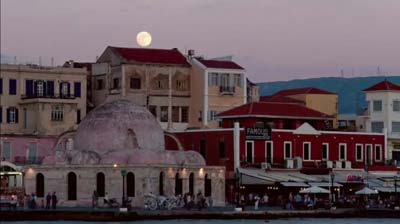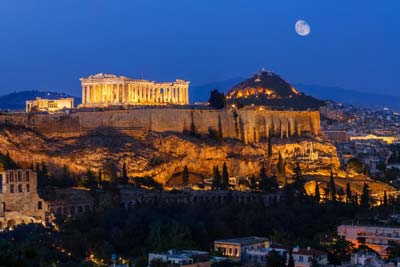
The Acropolis hill, also called the «Sacred Rock» of Athens, is the most important site of the city and constitutes one of the most recognizable monuments of the world. It is the most significant reference point of ancient Greek culture, as well as the symbol of the city of Athens itself as it represent the apogee of artistic development in the 5th century BC.
A visit to Athens is not complete without visiting the Acropolis, hundreds of tourists each day accordingly make the pilgrimage. Acropolis from Filopappou Hill.
Acropolis at dusk from Lycabettus Hill.Acropolis from Monastiraki.The Acropolis of Athens is an ancient citadel located on a high rocky outcrop above the city of Athens and contains the remains of several ancient buildings of great architectural and historic significance, the most famous being the Parthenon.
Although there are many other acropoleis in Greece, the significance of the Acropolis of Athens is such that it is commonly known as «The Acropolis» without qualification.While there is evidence that the hill was inhabited as far back as the fourth millennium BC, it was Pericles (c. 495 – 429 BC) in the fifth century BC who coordinated the construction of the site’s most important buildings including the Parthenon, the Propylaia, the Erechtheion and the temple of Athena Nike.
The Parthenon and the other buildings were seriously damaged during the 1687 siege by the Venetians in the Morean War when the Parthenon was being used for gunpowder storage and was hit by a cannonball.
The Acropolis was formally proclaimed as the preeminent monument on the European Cultural Heritage list of monuments on 26 March 2007.
 |
| From acropolis to Pireaus, Athens, Greece. |
 |
| Amphitheater in Acropolis, Athens, Greece. |
 |
| The Caryatid Porch of the Erechtheion, Acropolis, Athens, Greece. |
 |
| Erechtheum, Acropolis of Athens, Greece. |
 |
| The Parthenon on the top of the Acropolis Hill, Athens, Greece. |
 |
| The Propylaea of the Acropolis from inside, Athens, Greece. |
On the Acropolis
The Parthenon: The largest temple on the Acropolis, originally dedicated to the goddess of the city, Athena. Built between 447 and 438 BCE at the height of the Classical period.
The Temple of Athena Nike: First temple on the Acropolis to be built in the Ionic style, and one of the few exemplars of an amphiprostyle temple in all of Greece: what made it truly unique was the unit by which it was planned, which turns out to be the Egyptian foot of 300 mm.
The Erectheion: Dedicated to the worship of the two principal gods of Attica, Athena The Propylea: The ancient monumental gateway to the Acropolis.
On the South Side
The Odeon of Herodes Atticus: This ancient theatre is still used today for concerts and plays.
The Theatre of Dionysus.
Museums
New Acropolis Museum. Designed by Swiss architect Bernard Tschumi at a site south of the Acropolis, opened in June 2009. Located in Makryanni just below the Acropolis, it’s easily accessed from the Acropolis station of the Metro.
 |
| Acropolis of Athens. |
 |
| Acropolis of Athens. |
 |
| Odeon of Herodes Atticus, Acropolis of Athens. |
Following European regulations, disabled access to the Acropolis can be gained by means of special paths and a purpose-built lift on the north face of the hill. Apparently this is only for the use of those in wheelchairs.
Websites
Acropolis of Athens
Acropolis Museum
 |
| The Parthenon, Acropolis, Athens. |















































